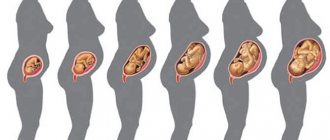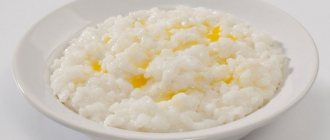Cereals are introduced into the child’s diet when he is completely accustomed to vegetable puree (not earlier than a month after its introduction). It is worth recalling that the first complementary foods for breastfeeding begin at 6 months, for artificial feeding - 4.5-5 months. However, if the baby is not gaining weight well, has problems with bowel movements and a tendency to regurgitate, the doctor will recommend using porridge for the first feeding.
When we introduce complementary foods
When your baby turns 6 months old, you can safely start introducing him to adult food.
At this age, for full growth, the baby’s body requires many useful substances, such as iron, iodine, vitamins A, C and D, group B, folic acid, copper, zinc, calcium, selenium, potassium and phosphorus.
Breast milk continues to provide the baby with all the vitamins he needs, but the baby develops an interest in new foods. This is the ideal moment for the first feeding.
There are two types of complementary foods:
What is the difference?
Pedagogical is introducing the child to the food that adults eat.
- With this type of complementary feeding, he develops a food interest and learns to eat on his own;
- In this complementary feeding there is no goal to feed the baby, you give him food in micro doses and he gets acquainted with different tastes;
- The baby is given complementary foods when he shows interest in food.
Pediatric complementary feeding is the gradual introduction of foods into the baby’s diet, in accordance with his age and according to the recommendations of pediatricians. It is introduced according to a special calendar and does not imply the development of children's independence and consideration of the child's wishes.
To determine your baby's readiness for adult food, you need to observe him.
- If the child is 6 months old, has doubled his birth weight and shows interest in food, opens his mouth when you bring him a spoon, then you can start the first feeding.
To learn about your baby’s readiness for complementary feeding, watch my video tutorial:
Do you always follow doctors' orders?
Yes, they know us better.
43.82%
Not always, because more information can be obtained from other women in labor.
20.88%
I comply, but I check reviews and advice from various mothers.
35.29%
Voted: 340
It is better to start complementary feeding with vegetables or cereals. Also read the current article: How to feed a child correctly?>>>
Several rules for introducing first complementary foods
According to WHO recommendations, the first complementary foods should be offered to a child no earlier than 6 months of age.
There are several signs that a baby is ready for complementary feeding:
- The child's tongue thrust reflex has faded. When you try to let him drink from a spoon, he does not push the spoon out with his tongue. After all, complementary foods must be given exclusively from a spoon. This is how the product receives initial treatment with saliva.
- The baby doubled his weight from birth.
- The baby can consciously lean back and can control the turns of his head. It is necessary that the baby can turn his head to the side if the proposed product is not to his taste.
- The child has a food interest; he is keenly interested in what is on mom or dad’s plate.
- The baby has to be put to the breast more and more often. He eats two breasts in one feeding and does not get full.
- If the baby is bottle-fed, the signal to introduce complementary foods is the moment when he does not get enough of the usual amount of formula recommended for his age.
This moment occurs closer to six months of age. By this time, children's physical activity increases noticeably. Almost every day they acquire more and more new skills, which they practice in motion.
Here is a baby, for example, only yesterday he learned to roll over in both directions. And today he gets on all fours, tomorrow he sways and makes short pushes forward. He's about to crawl.
And when the baby crawled and learned to stand at the support. He quickly begins to understand that his legs can help him move faster. And he learns new motor skills - he tries to walk.
If the baby's physical activity has increased, he needs more energy-intensive and high-calorie food. So complementary foods are such food.
Before introducing any complementary foods, you need to know the following.
- Complementary foods are administered only to a healthy child.
Useful: How, when and in what quantities to introduce egg yolk into complementary foods?
Even situations such as vaccination, moving, recent illness or illness in a person from the child’s immediate environment must be taken into account. At this time, you need to wait a while with complementary foods.
- Complementary foods are introduced gradually (5 g on the first day, then 10 g on the second, 20 g on the third day, etc.). After trial spoons of complementary feeding, the baby needs to be supplemented with breast milk or formula. Within 10-14 days, the volume of the fed product should reach the volume of one meal. This way you will replace one feeding with complementary foods.
- Complementary foods should be introduced in the morning. This way you can monitor the child’s possible reaction to a new product (changes in behavior, rashes, regurgitation, changes in stool).
- Only one complementary food should be introduced at first. You cannot introduce several types of complementary foods at once. But when you have introduced complementary foods, the child has gotten used to it, eats willingly and absorbs it well within 3-4 weeks, then you can start a new product.
Types of cereals for complementary feeding
Porridge is considered a very important and necessary product in baby food.
- It is very rich in microelements and has a good effect on the baby’s digestive system;
- It contains B vitamins, carbohydrates and protein.;
- Cereals are a source of carbohydrates that provide energy to a small body. They have high nutritional value and contain many useful nutrients that are necessary for a growing body.
Porridge can be introduced into a child’s diet as early as 6 months.
If you are going to introduce complementary foods with store-bought cereals, then you should know the following. There are several types of store-bought complementary feeding cereals:
- dairy-free and dairy-free;
- gluten-containing and gluten-free;
- multi-component and single-component;
- hypoallergenic and fermented milk.
Therapeutic and prophylactic porridges, which contain pro and prebiotics, are also sold. This product restores the balance of intestinal microflora.
- Start complementary feeding with store-bought food, preferably cereal without milk. Cow's milk is currently considered the No. 1 allergen.
- Choose one-ingredient dairy-free cereals for your first complementary feeding. They must not contain gluten, starch, sugar or other additives.
Most often, complementary feeding is started with buckwheat and rice porridge. After the baby gets used to these dishes, his diet can be expanded with corn and wheat porridge.
The procedure for introducing cereals into the diet
Which porridge is best for first feeding?
- It’s better to start with buckwheat, it contains B vitamins, iron, protein, magnesium. It is simply necessary for children with low hemoglobin. Buckwheat porridge for the first complementary feeding is considered the most suitable option;
- Rice porridge is needed for babies who do not gain weight well and often suffer from loose stools. It contains a lot of dietary fiber;
Know! Do not be afraid to feed your baby rice porridge, thinking that it causes constipation. It is not true. Food made from broken rice leads to this problem, but dishes made from rice cereal do not have this effect.
- Corn porridge, as a complementary food, is also considered a valuable product. It contains a lot of fiber, protein and microelements. Try introducing it after rice and buckwheat. Next, introduce your child to oat and wheat cereals;
When introducing porridge into a child’s diet, you need to consider what type of complementary feeding you are practicing.
- In pedagogical complementary feeding, we start giving porridge with microdoses, do it slowly and look at the child’s reaction;
- The condition of the skin, stool, and behavior of the baby is assessed;
- If the porridge does not cause any undesirable effects, then we introduce you to the next type of porridge. That is, there is no sequence for introducing porridges as described above. The child adapts to the family’s food type and gets acquainted with the porridges that you prepare.
In pediatric complementary feeding, the rules are slightly different, which often lead to overfeeding of the child and refusal of complementary feeding at the age of 8-9 months.
What pediatricians most often recommend:
start accustoming your child to this dish with a teaspoon, then increase gradually until you reach the amount of 150 grams
This is too large a volume that even a 9-month-old child cannot eat. Due to such volumes of porridge, constipation may occur.
Therefore, before introducing complementary foods or increasing their volumes, watch the online course ABC of complementary feeding: a system for the safe introduction of complementary feeding to infants>>>
- Semolina can be introduced into the baby menu only from 1 year of age.
Buy or cook yourself?
Which porridge is better for the first feeding, purchased or the one you cook yourself?
It all depends greatly on your preferences.
Many modern mothers buy ready-made products in boxes for complementary feeding. Why this food is convenient:
- no need to stand at the stove: fill it with water and you’re done;
- baby food is checked for quality and fully tailored to the needs of the baby;
- You can choose different types of cereals, which significantly reduces the risk of allergies in your child.
How to cook porridge for your baby at home
If you decide not to buy a finished product, but to prepare it yourself, first you must select and prepare the cereal correctly. The best porridge for babies is buckwheat.
Do not look for grains that are too dark in color; it would be preferable to cook light-colored grains. If the baby doesn’t like the dish, most likely there were mistakes when introducing complementary foods to the baby.
How to prepare porridge for the first feeding:
- sort out the cereal and grind it in a blender;
- add water and cook over low heat for 10-15 minutes, stirring;
- You cannot salt the porridge and add sugar and spices to it.
If you have already introduced your baby to vegetable oil and butter, then add 5 grams to the dish.
Children's porridges are cooked only in water. After 8 months, feel free to add fruits or vegetables to the dish, after chopping them.
Vegetables such as pumpkin, zucchini, and carrots are suitable for this. From fruits, you can add an apple, dried apricots or fresh apricots, as well as plums and peaches.
To taste the porridge, your baby only needs one teaspoon.
It’s up to you to decide which porridge for first feeding is best for your baby. But do not forget that a new product in a child’s diet, even porridge, can cause allergies. You need to monitor your child and stop feeding in time if there are severe rashes or constipation.
Complementary feeding, although a simple science, has its own tricks and dangers. Therefore, the easiest way is to first watch the free seminar Five mistakes when introducing complementary feeding to an infant>>>
Which porridge did you choose for your first complementary feeding?
- dairy-free and dairy-free;
- gluten-containing and gluten-free;
- multi-component and single-component;
- hypoallergenic and fermented milk.
Porridge with added fruits or berries, “3 grains”, “5 grains”
If the period of introducing monocomponent cereals has passed without any reactions, then from 7-8 months you can expand the list of products.
You can try giving your baby porridge with the addition of fruit that he has already tried and tolerates well. Helpful: What should babies be fed at 10 months?
For example, a child eats buckwheat well and there are no negative reactions to an apple. Then calmly introduce buckwheat porridge with apple.
It is better to introduce porridge with berries after 9-10 months.
After 8 months, the child can be offered “3 grains” porridge, which includes rice, buckwheat and corn cereals. A little later, you can introduce the baby to five-grain porridge (millet, buckwheat, rice, corn, oats).
How to prepare porridge for first feeding
Cereals add variety to the baby's diet and replenish the body's energy reserves. Preferring the home method of cooking, the mother faces the question of how to prepare porridge for the first feeding and preserve all the useful microelements.
Table of contents
Choice of cereals
According to WHO, grains are the second stage of complementary feeding for infants, both breastfed and bottle-fed.
Cereal complementary foods are introduced after the baby is introduced to vegetables.
Up to 6 months, infants receive lactotrophic nutrition (milk) and enzymes for digestion are supplied with breast milk or formula.
Vegetables help prepare the digestive system to digest richer foods by stimulating the production of enzymes by the pancreas and liver.
Without preparing the digestive system, cereals will not benefit the body. Lack of enzymes will lead to indigestion and nutrients will not be absorbed, and the body will waste energy breaking down food.
Cereals for first feeding must meet the following criteria:
- Hypoallergenic.
- Gluten free (complex protein).
- Quality (top grade).
For medical reasons, cereals are included first in a child’s menu (underweight).
Cereals contain slow carbohydrates, and take longer to digest in the gastrointestinal tract than vegetables (up to 4 hours).
Blood sugar levels gradually increase. Absorption of nutrients from the intestines occurs in several stages - this allows you to prolong the feeling of fullness.
How to choose quality cereals
For the first complementary foods, pediatricians advise choosing rice or buckwheat groats. These grains do not cause allergies and are completely digestible.
Buckwheat kernels are rich in iron and B vitamins. For constipation, porridge helps improve the functioning of the intestinal tract.
Useful tips for mothers: FIRST FEEDINGS
Rice grains contain a lot of starch, which coats the mucous membranes of the gastrointestinal tract. For diarrhea, porridge helps retain water and prevent dehydration.
Buckwheat has a more saturated chemical composition; rice loses many valuable microelements during processing (grinding).
The pediatrician will advise which porridge to start complementary feeding with, since the child’s overall development and compliance with standards are taken into account.
What to look for when choosing grains:
- degree of kernel purification;
- whole or crushed grains in packaging;
- color;
- impurities in packaging (husks, garbage);
- smell.
You can only examine cereals in transparent packaging or if the grain is sold in open containers (bags). The quality of grains and processing technology affects the nutritional value of cereals.
High-quality buckwheat is called kernels (grade 1). The kernels are placed in a package whole and peeled from the fruit shell. The highest grade of cereal has a light brown color.
Poor quality of raw materials is indicated by crushed and broken grains, as well as an admixture of garbage and husks.
The highest grade of rice has the inscription on the packaging - polished. The split grains are of low grade because they are considered a waste product from rice processing.
High-quality grain is white, without a yellow tint. The grains should be the same size, even with a smooth surface. The polished grains are well cleaned and have no shine.
When choosing cereals, you should pay attention to the smell. If even a faint smell of spoilage is felt, this indicates a violation of the temperature regime of storage.
High humidity is a habitat for fungi. Rotted cereal can be dangerous to the baby's health.
We cook it ourselves
Cow's milk is not used to prepare the first cereal supplement.
A child's digestive system is not yet ready to digest and absorb the complex protein casein.
Cereals for infants are prepared in water or vegetable broth. It is forbidden to add sugar and salt to the dish.
Porridge for first feeding is prepared from only one type of cereal. This is necessary to adapt the gastrointestinal tract and monitor allergic reactions.
Before cooking, the grains are sorted and thoroughly washed under running water. Pre-dried cereals (in the oven) can be ground into flour - this will speed up the preparation of the dish.
It is recommended to soak rice in warm water for several hours to remove excess starch.
The baby's first cereal complementary food is boiled to a liquid consistency so that it does not cause difficulty in swallowing.
The finished dish should be homogeneous. The volume of a serving of cereal complementary foods should not exceed 150 milligrams.
The presence of teeth does not indicate a baby's readiness to chew food. The chewing reflex has not yet been formed; thick food or lumps in porridge will cause a gag reflex.
But what about semolina porridge - the porridge of our childhood?
Semolina porridge has long been a favorite among other porridges for baby food. Largely due to the availability, speed of preparation, suitable delicate consistency and structure of the porridge.
A couple of decades ago there was practically no alternative to it. More than one generation of children has been raised on semolina porridge. But now that it is known that there are healthier cereal grains than semolina (crushed wheat), experts recommend not giving semolina to infants.
Semolina contains a lot of starch, but it does not contain enough microelements and vitamins for the full growth and development of a child. In addition, phytin contained in semolina interferes with the absorption of calcium, iron and vitamin D.
As a result, children who receive semolina porridge early and often are prone to iron deficiency anemia (low hemoglobin) and rickets. The bones of such babies become weaker and thinner. Moreover, the load on weakened bones increases, since the child will gain weight from semolina quite quickly.
As a result, calcium deficiency in combination with excess weight will quickly lead to bone deformation in such babies. Therefore, children under one year old or even until kindergarten should not be given semolina.
The best cereals for first feeding
Let us remind you that there are no strict recommendations on where to start complementary feeding. You can and should introduce a variety of foods, focusing on the degree of readiness of the baby for complementary feeding. You can read more about the rules for introducing complementary foods here. However, in Russia it is customary to start complementary feeding with vegetables or cereals, especially if the child is not gaining weight very well. We will talk about the best baby cereals for first feeding in this article.
“Porridge is a source of slow carbohydrates, they are digested and absorbed gradually, gradually increasing blood sugar levels, providing the child with a feeling of fullness and energy for a long time,” says Anna Levadnaya, pediatrician, candidate of medical sciences, author of a blog about pediatrics and not only on Instagram @ doctor_annamama. “In addition, porridge is one of the main sources of B vitamins; they are needed for the development of the nervous system, growth of skin, nails and hair. Porridges also contain rutin, iron, vitamins A, E, folic acid and other beneficial substances.
There are gluten-free porridges - rice, buckwheat and corn. They rarely cause allergies, so they are recommended at the very beginning of introducing complementary foods. Gluten porridges include oatmeal, wheat, semolina, pearl barley, barley and others. If the child is healthy and does not have gluten intolerance, then these cereals are also recommended to be included in the baby’s diet. Up to a year - oatmeal and wheat are usually introduced.
Children's cereals are also divided into dairy and dairy-free. Dairy-free is recommended at the beginning of the introduction of complementary foods, as well as for children with allergies to cow's milk protein and breastfed children. Dairy milk can be based on an adapted milk formula or cow's or goat's milk.
— If a child is not allergic to cow’s milk protein, milk porridge can be included in the diet for up to a year. However, if the baby eats dairy-free porridge well, then in children under one year of age it is better to give preference to dairy-free porridge made with breast milk or formula, notes Anna Levadnaya. – Whole milk is not recommended to be included in the diet for up to a year due to the high load on the gastrointestinal tract.
Also, at the very beginning of complementary feeding, it is better to give preference to monocomponent cereals. They are easier to digest and there is less risk of developing allergies. Porridges consisting of several grains, as well as with the addition of vegetables and fruits, are best introduced into the baby’s diet a little later. The same goes for sugar and salt - they are not recommended in cereals for the first feeding.
“That is, the very first porridge should be gluten-free - buckwheat, rice, corn, dairy-free, monocomponent, without sugar and without fruit and vegetable additives,” says our expert.
“Porridge is a source of slow carbohydrates, they are digested and absorbed gradually, gradually increasing blood sugar levels, providing the child with a feeling of fullness and energy for a long time,” says Anna Levadnaya, pediatrician, candidate of medical sciences, author of a blog about pediatrics and not only on Instagram @ doctor_annamama. “In addition, porridge is one of the main sources of B vitamins; they are needed for the development of the nervous system, growth of skin, nails and hair. Porridges also contain rutin, iron, vitamins A, E, folic acid and other beneficial substances.
Vegetables for complementary feeding
It is better to start complementary feeding with white or green vegetables, as they are low-allergenic and neutral in taste. Zucchini, broccoli, and cauliflower are good options. Then you can add potatoes and white cabbage to the baby’s diet. Closer to 8 months, you can start introducing brightly colored vegetables - carrots, pumpkin, etc.
All vegetables are rich in certain vitamins and microelements; they have a wonderful effect on the child’s gastrointestinal tract. We can talk endlessly about the benefits of vegetables, here are just some facts confirming their necessity in a baby’s diet, as well as some warnings to remember.
Zucchini is the least allergenic. It is well digested and absorbed, does not injure the baby’s delicate gastrointestinal tract, and at the same time stimulates intestinal motility. Potatoes help remove toxins from the body, but they should be used with caution, as they can cause allergies. Carrots, due to the carotene they contain, are very beneficial for growth and vision.
But it can cause allergies, moreover, it is better to use it not in its pure form, but as one of the ingredients in vegetable puree, so as not to provoke carotene jaundice (although it is not dangerous to health, it can quite frighten parents).
Pumpkin is rich in vitamin D, which is essential in the cold season, but like carrots, it is better to eat it with other vegetables, and if as an independent dish, then a maximum of 2-3 times a week. White cabbage, for all its unsurpassed usefulness, has a rather aggressive effect on the baby’s gastrointestinal tract, which can manifest itself as increased gas formation and stool upset.
How to cook your first baby porridge
It is recommended to start feeding your baby at 6 months, and baby cereals are best suited for this. Follow our tips, and preparing your first delicacy will be easy and simple. Wash your hands, take a baby spoon, a cute plate and delicious porridge. And don't forget your camera to capture such an important moment!
It is recommended to start feeding your baby at 6 months, and baby cereals are best suited for this. Follow our tips, and preparing your first delicacy will be easy and simple. Wash your hands, take a baby spoon, a cute plate and delicious porridge. And don't forget your camera to capture such an important moment!
When and how to introduce the first complementary foods
Be careful when introducing new foods to your baby's diet. Typically, the age at which a child is ready to consume new food is determined by a pediatrician. Most often, baby puree , but if the baby is not gaining weight well and is prone to constipation after complementary feeding
, then
choose porridge .
Usually, vegetable puree is introduced into a child’s diet first, so that the child gets used to bland food, because if you give him tasty fruit purees, then in the future he is unlikely to want to try vegetables.
Many parents believe that the later they start complementary feeding, the easier the child will accept new food, but this is far from true. Every baby’s body needs additional vitamins and minerals. After all, the older a child grows, the more he can do and spends a lot of effort to show all his abilities. Therefore, you should not be scared or worry about the first poor absorption of new food; if you do everything correctly, then introducing complementary foods will not be a problem.
Complementary feeding scheme
First of all, these schemes were developed in order to avoid a negative reaction from the use of a new product on the child’s body. Digestive problems, constipation or diarrhea, flatulence and allergies are just a small part of the troubles that can happen to a child due to improper introduction of complementary foods.
So, how to introduce porridge into complementary foods? Rules and introduction scheme:
- A new product should be introduced into the diet only when the child is completely healthy and is not teething.
- How to prepare the first complementary food? Buckwheat porridge (this is the cereal you should start with) is diluted to the consistency of breast milk.
- The first portion of porridge is 0.5 teaspoon, the next day – 1 teaspoon, then – 3 spoons. Gradually, over 7 days, the volume should be increased to 150 ml.
- After 3-4 weeks, if the child does not have any negative reactions to this product, you should begin to introduce a new porridge into the diet.
Which porridge should I give first?
On this issue, the opinions of mothers are different: some prefer to start giving home-produced cereals first, while others buy ready-to-eat cereals.
But pediatricians recommend starting complementary foods with store-bought ones , which contain a full range of balanced substances and vitamins required for the child’s body. Their composition promotes better absorption for children's intestines.
Nowadays, on store shelves there is a huge selection of such products for different age categories of children.
For first feeding at home
Some still believe that homemade porridge is much healthier , so let’s try to give some tips on its preparation. Before preparing it, you need to carefully sort out the grains and rinse the cereal well . It is better to boil it in water , and immediately before use add 50 grams of baby formula or breast milk so that the taste is familiar to the child.
It is worth considering that when adding the mixture, different proportions must be observed ; it must diluted with more water than usual . Before cooking, the cereal can first be ground to obtain small grains, or after cooking, grind it with a blender.
Do not forget about the method of storing already prepared porridge, because in just half an hour it will be unsuitable for the baby to eat. Therefore, you should only give it freshly brewed.
The most popular types of cereal porridges:
- Dairy
- Dairy-free
- Gluten
- Gluten-free
- Instant children's
- Porridges that require cooking
- Drinkable or liquid
- Cereal mixture
Which cereals should you start complementary feeding with?
To decide which one is best to start feeding your baby with, you first need to think about its properties on the body.
For example, buckwheat contains a lot
- zinc;
- gland;
- as well as copper;
- magnesium;
- vitamins B1, B2 and PP
In addition, it does not contain gluten, which can cause allergies in a child.
You should not overuse rice , because it contains a large amount of dietary fiber. And the amount of useful elements and vitamins depends on the quality of grain cleaning. Also, boiling rice to a state that can be fed to a baby is unlikely to be possible. Moreover, during prolonged cooking, all useful substances die and evaporate . It would be better if you buy baby’s first rice porridge in the store, which you just need to fill with boiled water.
Oatmeal , of course, has a large amount of nutrients .
It contains:
- copper;
- zinc;
- iron;
- calcium;
- magnesium;
- as well as vitamins B1, B2 and PP;
In addition, it has a high content of vegetable protein and fiber.
A small drawback is the high presence of fats , so it is better to add such porridge for first complementary foods to the diet of active children and premature infants .
Millet is digested much worse than others due to its high content
- fatty acids;
- carbohydrates;
- cobalt;
- fiber.
As for pearl barley and barley cereals , the starch content in them is the same as in semolina, but the presence of vitamins and fiber is much greater . Millet is endowed with a large amount of plant proteins.
Should I buy ready-made porridge or make it myself?
Everyone chooses the answer to this question for themselves. But my opinion: it is better to take industrially produced cereals.
Firstly, the porridge is hermetically sealed, which prevents pathogenic bacteria from entering it. Industrial designs undergo several quality controls.
Secondly, ready-made cereals are designed taking into account the needs of the baby at different age periods. The nutritional value of the porridge and its content of vitamins and microelements are clearly defined.
Useful: Preparing vegetable puree for baby’s first feeding
Many commercially produced cereals are enriched with prebiotics and probiotics, which have a beneficial effect on digestive processes.
Plus, industrially produced porridges are easy to prepare. They are convenient to take with you to places where only boiled water is available. This is an important advantage of ready-made store-bought cereals.
As the time approaches for introducing complementary foods to the baby, the mother may acutely feel that the process of cooking takes up all her free time (if you can call it “free”).
In fact, imagine: the mother prepared the porridge, cooled it, fed the baby, and washed the dishes. Before I knew it, I already had to cook the vegetables. And again everything is in a circle. But you also need to feed the rest of the household. Therefore, ready-made porridges that do not require cooking greatly free up mother’s hands.
Therefore, sometimes the question of “cook it yourself or take ready-made porridge” is simply a question of whether mom has free time or not.
At first, when your baby only needs two spoons a day, you may not need to buy a whole package of instant cereal. After all, an open package can be stored for 14-20 days (depending on the manufacturer and additional components in the porridge).
Cooking conditions and proportions should be read on the packaging of instant cereals. But for the first complementary feeding, it is recommended to dilute 5 g of porridge per 100 g of water.
I’ll tell you straight: with this dosage, you get a very liquid porridge, which is inconvenient to give from a spoon. Therefore, you can prepare 10% porridge - 10 g of porridge per 100 g of water.











